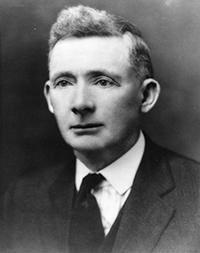

Thomas Nicholls Taylor, sometimes referred to as T.N.T., had a distinguished career as a LDS church leader, businessman, and politician. A biography by his son Thomas Sterling Taylor describes his contributions in detail.1
Thomas' father George Taylor was born in Birmingham, England, where he also married Eliza Nichols. The couple arrived in Utah in 1863, having walked most of the way across the plains. George Taylor became a prominent Provo businessman who also served on the City Council.2
Thomas Nicholls Taylor was born in Provo on July 28, 1868. He attended the Franklin School on Second South and First West and Brigham Young Academy. At age ten he began work in the family business, delivering furniture on foot. In 1885 he quit school, having reached the eighth grade.
Taylor's business career began in 1885 when he and Julius Jensen began Jensen & Taylor, the first exclusive jewelry store in Provo. The family business known as Taylor Brothers Company, begun in 1890, later became Taylor's, Inc., a department store in downtown Provo at the present site of the Continental Plaza, 250 West Center. Later the store moved to Provo's Central Square, the location now of the Mann Theater Complex. Taylor managed the store from 1890 to 1950. The family also owned fruit orchards in Orem, where the Osmond Studio and Cascade Gold Course now exist. The fruit was shipped by railroad to mainly the East.3 His farm and orchards were his most profitable ventures, but some businesses lost money.
Taylor was a key figure in several other business and civic causes. In 1906 he helped organize and was chosen president of the Farmers and Merchants Bank, but it failed in 1932 during the depression. He was a leader of Provo Woolen Mills and the Mapleton Sugar Company, but both also lost money. As a director of Beneficial Life Insurance Company and Home Fire Insurance Company of Utah, Taylor was well acquainted with LDS Church President Heber J. Grant, the president of both firms. In 1904 to 1906 Taylor was chosen the volunteer president of the newly created Provo Building and Loan Society, which helped 400 young families build homes. When World War I began, the Utah State Council of Defense chose T.N.T. to serve on its board and executive committee. Taylor was elected president of the Utah Bankers' Association in 1918. Appointed to the Mormon Battalion Monument Commission, he helped raise funds for a new monument.4
While Taylor was mayor from 1900 through 1903, one of his toughest choices came during a widespread smallpox epidemic. The Utah Health Commissioner, Dr. Theodore B. Beatty, enacted compulsory vaccination for small children. This decision was also supported by the Utah Medical Association. However, widespread criticism of the vaccination requirement centered on its violating individual rights. The Deseret News editor urged its legislative repeal, but LDS President Lorenzo Snow and his counselor George Q. Cannon favored vaccination. In Provo, Mayor Taylor accepted the advice of the city physician, Dr. Fred R. Taylor, to promote vaccination. Meetings were held to support and oppose it. Mayor Taylor was hung in effigy by vaccination opponents, a good indication of the divisiveness of the issue. Eventually critics gained the upper hand, resulting in the legislature passing a bill over the veto of Governor Heber M. Wells which ended compulsory vaccination in Utah.5 Other local developments in the Taylor administration included 1) placing street numbers on houses, 2) improving the baseball field in Pioneer Park, 3) changing the name of Main Street to Academy Avenue (now University Avenue), 4) purchasing a right of way to build a road to Utah Lake, 5) granting a franchise for a street car system, 6) expanding the City Cemetery, 7) starting postal deliveries, and 8) building the community's first cement sidewalks.6
Family and church were also priorities for Taylor. In 1889 he married Maud Rogers, the daughter of Isaac Rogers and Unice Stewart. They had nine or ten children, some born at the family home at 382 West 100 North in Provo. A later home at 342 North 500 West, built in the first decade of the twentieth century, still stands at that location. 7 His church callings included president of the YMMIA, bishop's counselor, and bishop. While president of the Utah Stake from 1919 to 1939, nine ward chapels were built. He died on October 24, 1950 and was buried in the Provo City Cemetery.8
Originally published in David M. Walden, Biographical Sketches of Former Mayors of Provo, Utah: A Report to the Provo Municipal Government, 1 Oct 1990, 49-52.
1 Thomas Sterling Taylor, The Life and Times of T.N.T.: The Story of Thomas Nicholls Taylor (Salt Lake City: Thomas Sterling Taylor, 1959).
2 T. Earl Pardoe, The Sons of Brigham (Provo: Brigham Young University Alumni Association, 1969). 215-218.
3 "Thomas Sterling Taylor Notes 100th Birthday," Daily Herald, 10 Jul 1990, B-3; Andrew Jenson, Latter-day Saint Biographical Encyclopedia: A Compilation of Biographical Sketches of Prominent Men and Women in The Church of Jesus Christ of Latter-day Saints (Salt Lake City: Andrew Jenson History Company, 1901-1935), vol. 3, 725-726.
4 "Thomas Sterling Taylor Notes 100th Birthday," Daily Herald, 10 Jul 1990, B-3; Andrew Jenson, Latter-day Saint Biographical Encyclopedia: A Compilation of Biographical Sketches of Prominent Men and Women in The Church of Jesus Christ of Latter-day Saints (Salt Lake City: Andrew Jenson History Company, 1901-1935), vol. 3, 725-726.
5 John Clifton Moffitt, The Story of Provo, Utah (Provo: J. C. Moffitt, 1975), 279; Joseph R. Morrell, Utah's Health and You: A History of Utah's Public Health (Salt Lake City: Deseret Book, 1956), 99-105.
6 Pardoe, 215-218; Moffitt, 134.
7 "Thomas Sterling Taylor Notes 100th Birthday"; Historic Provo: A Self-Guided Tour of Historic Architecture in Provo, Utah (Provo: Provo City Landmarks Commission, 2002), 9.
8 Pardoe, 215-218; Provo City Cemetery Records.
